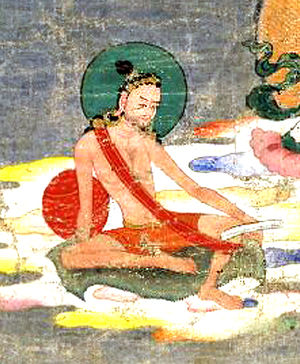docname
sangs rgyas sbas pa'i mgon (16th/17th centuries) in Tibetan. Buddhagupta-natha, a late Indian Siddha who visited Tibet and became one of the teachers of Jonang Taranatha. His own teachers were Tirtha-natha and the Mahasiddha Shanti-gupta. The fact that an Indian Siddha should appear so late in Tibet, shows clearly that the often repeated statement of Buddhism having become extinct in India after the 12th century Muslim invasions, is quite incorrect.
Also the famous scholar and yogin Vana-ratna (nags kyi rin chen, 1384-1468), teacher to such great Tibetan masters as Gö Lotsawa Shönu Pal ('gos lo tsA ba gzhon nu dpal, 1392-1481) and Thrimkhang Lotsawa Sönam Gyatso (khrims khang lo tsA ba bsod nams rgya mtsho, 1424-1482), who travelled to Tibet three times in the 15th century, is further proof of the ongoing practice and study of Buddhism in India after the onslaught of these invaders.
Vana-ratna was known as "the last great Indian scholar" to visit Tibet. Therefore one could certainly say that Buddhagupta-natha was "the last great Indian Mahasiddha" to do so.
Buddhagupta-natha was the son of a rich merchant. -> more coming soon...
In his biography of Buddhagupt-natha, Taranatha writes: "The signs and marks of his accomplishment as a yogin were plainly visible to ordinary eyes. Half the day he remained (in a state) whereby he cut off the flow of his breath; and at practically all times he stayed naked (throughout his stay in Tibet!). Not only did he not experience any harm from this, but his immediate entourage, within a two meter radius, could feel an intense heat, by means of which he was able to protect others from the cold. By cutting off the flow of his breath through mouth and nostrils, he was able to make appear to his eyes and ears whatever he wanted. Also, his feet did not sink on water; he was standing about two fingers above the ground and his bodily splendor would touch every object and remain there for a long time. He possessed the power of seeing others’ secret designs, in a supernatural way knowing others’ minds. His body was light: he would jump down from (a height of) two or three storeys, and like a skin that had been flung down, he landed gently like a feather. He would climb up a steep mountain as if it were flat land. Poison, quicksilver and the like were unable to harm his body. As his mind was abiding in steady loving kindness, dogs and even ferocious carnivores would lick his body and in other ways show their affection; ravens, little birds and so forth would alight on his lap or onto the tips of his fingers. They didn’t flee when he patted them, but remained where they were, obviously happy. At the time of bestowing an empowerment, he was able to make the wisdom actually descend. In the presence of worthy candidates he would show miraculous occurrences of various kinds, such as radiating light into the mandala. He stood in no need for the food of (ordinary) humans: he lived on (intangible) foods offered to him by non-human beings. When he was engaged in one-pointed deity yoga, the appearances of the present were really cut off and he was one endowed with the wisdom of at all times viewing everything outer and inner as devoid of any basis and as self-liberated. We with the scope similar to that of mayflies, how could we possibly evaluate the limit of his outstanding qualities of Body, Speech and Mind?"
Primary Teachers
- Tirtha-natha
- Shanti-gupta
Primary Students
- Nirvana-shri-pada
- Purna-vajra-pada
- Taranatha
